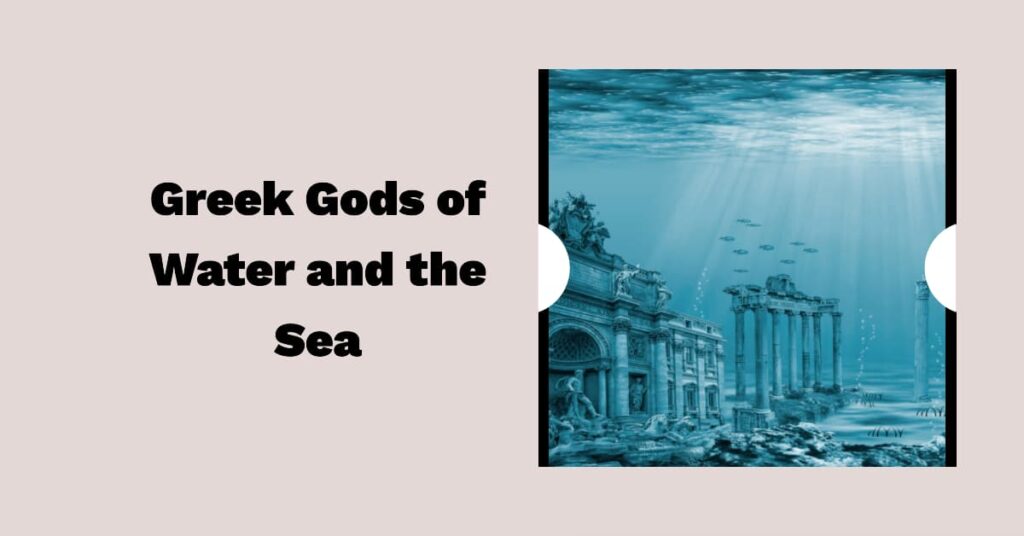The intriguing world of Greek mythology is filled with captivating narratives, and one of the most interesting aspects is the Greek Gods of Water and the Sea. These divine entities, rich with history and mystery, were revered in ancient times and still draw fascination today.
Not only were they central to mythology, but they also played an integral role in the daily lives of the Greeks, who depended heavily on the sea for their livelihood.

The Magnificent Pantheon of Watery Deities
Peeling back the waves of Greek mythology, you’ll find an array of gods and goddesses associated with the sea and water. These figures ruled over various aquatic realms and wielded their power in often-unpredictable ways. From the mighty Poseidon to the obscure sea nymphs, each of them has an exciting tale to tell.
Poseidon: The Mighty Earth-Shaker
Poseidon, the brother of Zeus and Hades, was the undisputed lord of the seas. Notorious for his powerful trident and volatile temperament, Poseidon was both respected and feared. Often depicted in seafaring tales, Poseidon was the one mariners would pray to for calm seas, and whose wrath they hoped to avoid, as it could result in catastrophic storms and shipwrecks.
Amphitrite: Queen of the Sea
Amphitrite, the wife of Poseidon, was the queen of the sea. According to the myths, she initially refused Poseidon’s advances and fled. The sea-god sent various creatures to persuade her, and eventually, she accepted his proposal. In many stories, Amphitrite represents the calm and serene aspects of the sea, a stark contrast to her husband’s tumultuous nature.
Triton: The Sea’s Herald
Triton, the son of Poseidon and Amphitrite, was a sea-god known for his distinctive conch shell trumpet. The sound of this trumpet was said to calm or stir up the waves. Half-man, half-fish, Triton was among the earliest merman figures in Greek mythology.
The Nereids and Other Sea Nymphs
The Nereids were 50 sea nymphs, daughters of the sea god Nereus and Doris. They often accompanied Poseidon and were particularly revered by sailors, who believed these benevolent beings could offer safe passage or rescue them from storms. Among the Nereids, Thetis and Amphitrite were the most well-known.
| Deity | Role | Symbol |
|---|---|---|
| Poseidon | God of the Sea | Trident |
| Amphitrite | Queen of the Sea | Dolphin |
| Triton | Herald of the Sea | Conch Shell |
| Nereids | Sea Nymphs | Various |
Interactions with the Mortals
The Greek Gods of Water and the Sea played a vital role in the mortal world. They were credited with providing bounty from the sea and were also known to unleash their wrath upon those who displeased them. For example, Poseidon was infamous for his grudges and vengeful nature. When King Minos of Crete failed to sacrifice a promised bull, Poseidon caused Minos’s wife to fall in love with the animal, leading to the birth of the monstrous Minotaur.
The sea gods were also known for their romantic pursuits, and these affairs often had significant consequences. For instance, when Poseidon fell in love with a mortal woman named Tyro, their union resulted in the birth of the hero Pelias, who would later play a significant role in the quest for the Golden Fleece.
Lessons from the Watery Myths
The ancient Greeks learned important moral and societal lessons from the tales of their sea gods. Poseidon’s stories often served as cautionary tales about respecting the gods and the forces of nature. His wrath upon those who crossed him was a stark reminder of the perils of hubris. On the other hand, the tales of the Nereids highlighted compassion, cooperation, and the necessity of helping those in need.
The Impact on Greek Culture
The sea and its associated deities played an integral role in shaping Greek culture. The ancient Greeks, being a seafaring people, built many of their cities near the coast. They depended heavily on the sea for trade, travel, and sustenance. Consequently, the gods associated with the sea and water held a prominent place in their religious practices.
Sacrifices and prayers were regularly made to Poseidon and other sea deities to ensure safe voyages and bountiful catches. The Isthmian Games, one of the major athletic festivals in ancient Greece, were held in honor of Poseidon. He also had many temples built in his name, the most famous of which is the Temple of Poseidon at Cape Sounion.
The sea gods were not only part of their religious practices but also influenced Greek art and literature. They were popular subjects of pottery, sculptures, and mosaics. In literature, they made frequent appearances in epic poems like the Iliad and the Odyssey, tragedies, and other classical works.
The Modern Relevance of Greek Gods of Water and the Sea
Even in today’s modern era, the influence of the Greek Gods of Water and the Sea can be seen in various aspects of popular culture. They are depicted in nautical and sailing movies, novels, video games, and TV shows, thereby keeping these ancient tales alive. More importantly, these gods symbolize timeless themes of power, nature, passion, vengeance, and redemption, which continue to resonate with people worldwide.
In a broader sense, these tales remind us of the formidable power of the sea and nature in general, and the respect it deserves. In an era where climate change and environmental degradation are of increasing concern, these ancient myths can be seen as early warnings about the potential consequences of mistreating nature.
The Flip Side of the Coin
However, fascination with these gods and their tales has its drawbacks. One could argue that it may glorify the pettiness, cruelty, or immoral behavior exhibited by some of these divine beings. Additionally, the often-excessive anthropomorphizing of natural elements could distract from scientific understanding and appreciation of nature.
Adorning the Skin with the Tales of the Sea: Greek Gods in Modern Tattoos
In the colorful realm of modern body art, the Greek Gods of Water and the Sea are making waves. Tattoos inspired by these aquatic deities have surged in popularity, captivating tattoo enthusiasts with their potent symbolism, rich imagery, and timeless appeal.
Poseidon: Power and Freedom
Poseidon, with his trident in hand and the sea at his command, is a popular choice for tattoo art. He symbolizes power, strength, freedom, and, to some extent, unpredictability. A Poseidon tattoo can represent a respect for the sea, an affinity for Greek mythology, or simply a love for its striking imagery.
The designs can vary greatly, from a majestic, full-bodied Poseidon riding the sea waves to a simple, minimalist design of his iconic trident. Placement is often on larger areas like the back, chest, or arms, allowing for the intricate detailing often associated with these tattoos.
Triton: Guide Through Life’s Waves
Triton, with his unique merman form and conch shell, offers another fascinating design for tattoos. Symbolizing guidance and safe passage through life’s turbulent waves, a Triton tattoo could serve as a personal talisman. The designs are usually intricate and well-suited for large spaces like the back or the forearm.
Nereids: Symbols of Grace and Protection
For those seeking a more delicate, feminine touch, the Nereids present an enchanting option. These sea nymphs embody grace, beauty, and benevolence. In tattoo art, they can be depicted as ethereal, mermaid-like figures, often accompanied by elements of the sea. A Nereid tattoo might be a symbol of protection, kindness, or a deep connection with nature and the sea.
Amphitrite: Serenity and Strength
Amphitrite, as the queen of the sea, embodies both serenity and strength. Her tattoos often depict her with marine creatures, emphasizing her dominion over the sea. Those who choose Amphitrite may identify with her resilience, sovereignty, and calm demeanor, even amidst the chaos of the ocean.
The Significance and Appeal
Beyond their visual allure, Greek sea god tattoos offer a personal and profound means of self-expression. They carry centuries-old tales and symbolism, enabling the wearer to connect with the ancient past, the power of the sea, and the enduring themes that these gods represent.
These tattoos can also serve as a daily reminder of one’s love for the sea, a respect for nature’s formidable power, or personal attributes such as strength, resilience, or a free spirit. Whether it’s a majestic Poseidon that adorns the skin, a graceful Nereid, or the compelling Triton, these tattoos capture a piece of ancient mythology and carry it into the present day, making the wearer a walking, living canvas of these timeless tales.
However, the flip side is that tattoos are a lifelong commitment, and the decision to get one should be made with careful consideration. Also, the meaning of these tattoos can be subjective and might not always be clear to the casual observer.
Final Thoughts
In the grand tapestry of Greek mythology, the Greek Gods of Water and the Sea represent a vital thread. Their tales offer a rich blend of history, culture, and lessons that continue to intrigue and inspire. Regardless of the occasional moral ambiguity of these gods’ actions, there is no denying their central role in the captivating saga of Greek mythology.
Whether we view them as symbols of power and nature or as characters in fascinating stories, the sea gods of ancient Greece hold a unique place in world mythology. Their tales serve as a testament to the ancient Greeks’ deep reverence for the sea, a sentiment that still holds true for many of us today.
- 11 Boat Salvage Yards in Texas – January 18, 2025
- 7 Boat Salvage Yards in Michigan – January 15, 2025
- Fire Hose SOLAS Requirements, Regulation 10: Ensuring Maritime Safety – January 9, 2025




